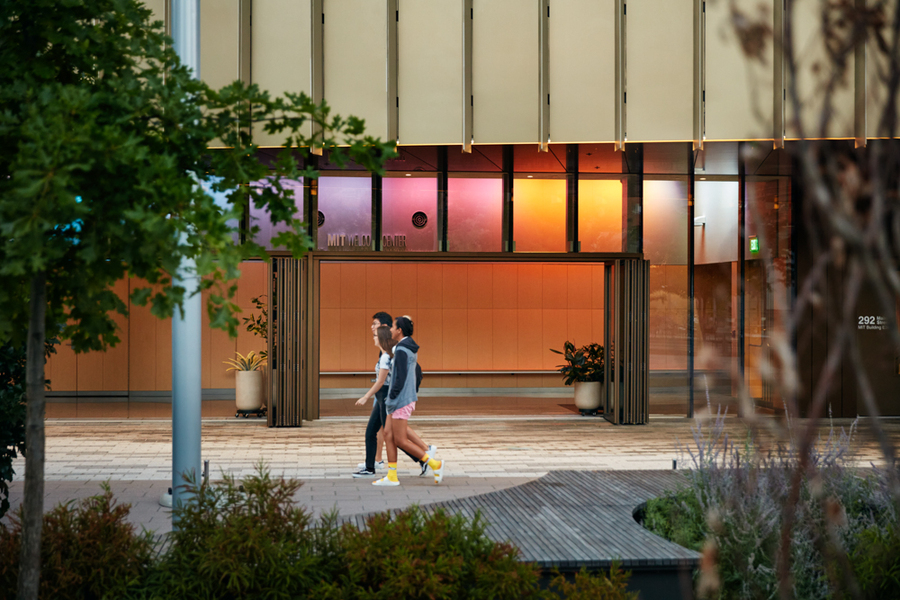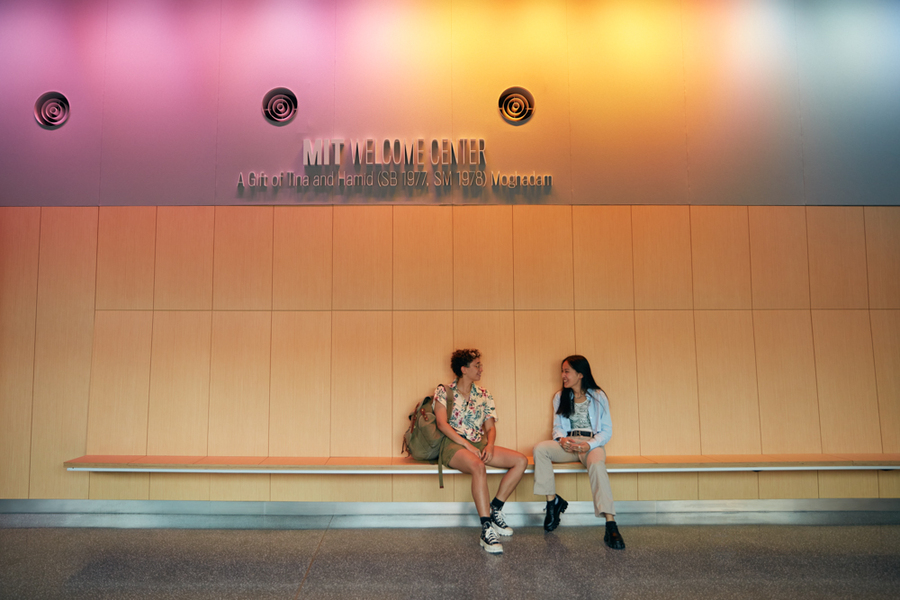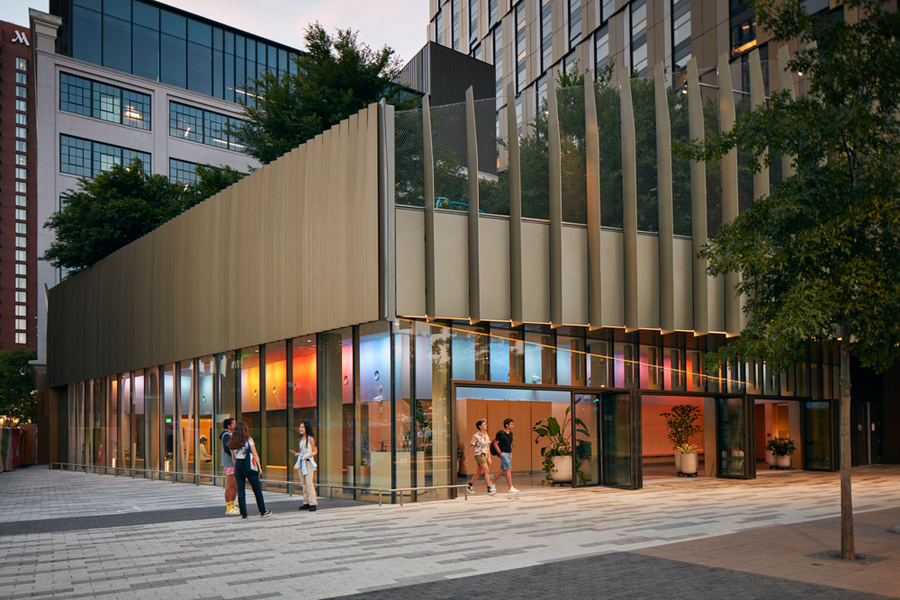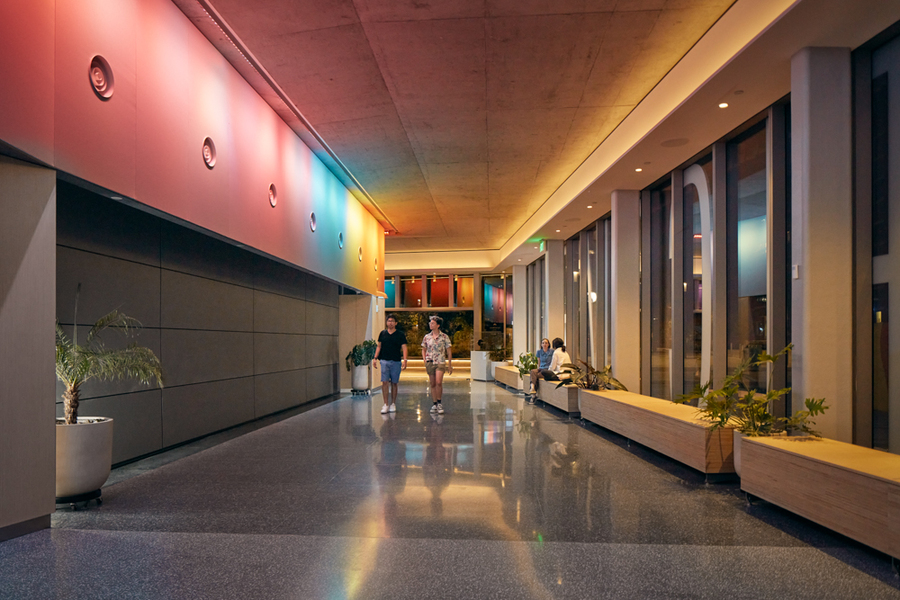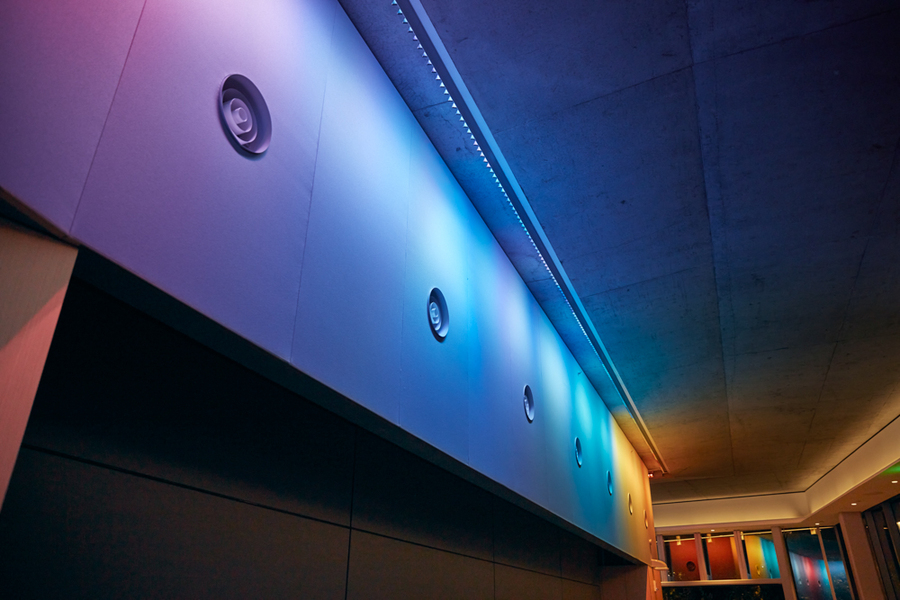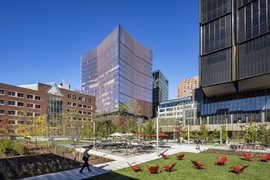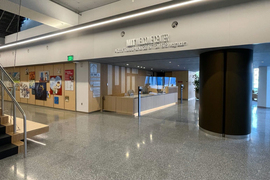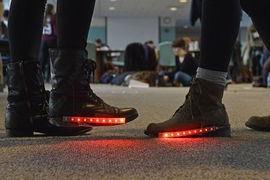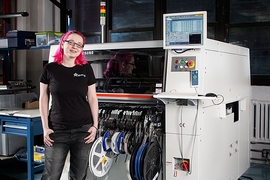Recently, MIT Admissions and MIT Open Space Programming jointly launched a new lighting installation, “MIT Illuminations,” in partnership with SOSO, an MIT-alumni founded experiential design firm. The installation spans 120 linear feet, indirectly illuminating an acoustical fabric frieze within the new MIT Welcome Center, and by night transforming the center into a colorful, inviting beacon in Kendall Square, Cambridge, Massachusetts.
With an open glass facade and a large ground floor auditorium, the MIT Welcome Center — a gift of Tina Moghadam and Hamid Moghadam ’77, SM ’78 — is part of MIT's new gateway in Kendall Square and is envisioned as a new starting point for visitors to the campus. Inspired by the concept “only at MIT,” the Welcome Center's artwork, lighting, and interiors evoke MIT’s eclectic, creative, and hands-on culture.
“The lights, like the MIT community, are colorful, evolving, and full of life,” explains Chris Peterson SM '13, director of special projects at MIT Admissions and Student Financial Services and a lecturer in comparative media studies. "We wanted to highlight the human element of MIT with an installation that felt as vivid and organic as our community in fact is, and that could serve as an educational opportunity as well."
Video: Melanie Gonick/MIT
A platform for creative computation and open education
Custom software written by SOSO transforms a library of scientific imagery, audio streams, and data feeds into colorful animations that project ambient, abstract scenes across the fabric of the frieze. A web-based interface allows the Welcome Center team to select these inputs — an iconic Doc Edgerton stroboscopic photo, the live speech of a lecturer, an API tracking clean energy usage in real time — and render them as light, illuminating the inside of the center and reflecting out into the Kendall/MIT Open Space beyond.
While the current content library has been developed by the MIT Admissions and MIT Open Space Programming teams, MIT staff envision partnering with others to further develop the materials in the future. "We’re looking forward to working with collaborators from around the Cambridge, Kendall, and MIT communities on this creative endeavor," says Jess Smith, director of MIT Open Space Programming.
However, the impact of the “MIT Illuminations” project isn't limited to Kendall Square. All of the code that interfaces with the lights has been published to GitHub under an MIT license, with simple instructions for how to create a similar lighting system at home using an inexpensive consumer option, such as the NeoPixels LED lights made by Adafruit Industries.
“At the core of this project is the idea of enabling creativity with technology. We wanted to extend the engagement of the project beyond the physical Welcome Center,” says Justin Manor '00 SM '03, director of innovation at SOSO. “So we created an open source toolkit that gives everyone an accessible introduction to programming lights.”
A companion website at illuminations.mit.edu displays the code and content currently driving the lights in the Welcome Center, and also provides links to the open-source software for individuals to learn how to create their own lighting kits at home. Since off-the-shelf lighting systems with comparable capabilities are prohibitively expensive for noncommercial use — often costing tens of thousands of dollars for systems with relatively limited features and closed codebases — the free software behind “MIT Illuminations” lowers barriers for everyday people to experiment with creative computation.
“MIT has a foundational commitment to the public interest, reflected in our long tradition of open source code, OpenCourseWare, and open access scholarship,” Peterson says. “We see the “Illuminations” project as a continuation of that history; that when MIT shares what it has, it is a good thing, both for the world, and for MIT.”
Last fall, Peterson and Victor Hung ’14 — a longtime instructor for the iconic 2.009 and 2.00b courses in the Department of Mechanical Engineering, cofounder of the immersive entertainment company Boxaroo, and creative designer of the large-scale interactive challenge arcade Level99 — taught a first-year advising seminar based on the “Illuminations” toolkit. Assisted by six MIT undergraduate learning assistants, they worked with dozens of first-year students to introduce them to the principles of creative computation using the open-source code, help them explore new modes of artistic expression and technical creativity, and produce more content with which to light the MIT Welcome Center.
Hung, who developed the curriculum for the seminar, then spent this January's Independent Activities Period working with the learning assistants and Assistant Director of Admissions Ceri Riley '16 — an experienced science communicator with a background in K-12 educational media — to adapt it for the general public. Their guide is now published at learn.illuminations.mit.edu. “The goal is to introduce people to that intersection of technology and art," says Hung, "where there are so many unique and unexplored ways to infuse delight into the world.”
Made by the MIT community
The “MIT Illuminations” project represents the culmination of years of collaboration between MIT students, staff, researchers, and alumni that began before the MIT Welcome Center even opened.
The idea to use programmable, colorful lighting was inspired, in part, by prior art on the MIT campus, including the LightBridge installation for MIT's 150th anniversary, the Green Building when community members turned it into a playable game of Tetris or the Great Dome into a rainbow for Pride, and the LED lights installed into the ceiling of one wing of the East Campus dormitory.
SOSO, founded by Manor with fellow MIT alumni Eric Gunther '00 MEng '02, and John Rothenberg '02 SM '07, worked with MIT Admissions and MIT Open Space Programming to conceptualize, design, and program the lights. The team blends architecture, computer science, and media arts to create spaces that engage audiences through discovery and emotional connection. In addition to the “MIT Illuminations” project, the SOSO team is working with MITIMCo to design lighting elements in the new inbound Red Line headhouse on the MIT campus in Kendall Square.
Their work was built on Processing, an open source graphical programming language developed at the MIT Media Lab by Ben Fry SM '00 PhD '04 and Casey Reas SM '01, and P5.JS, a Javascript implementation of Processing for the web created by Lauren McCarthy '08. The open source documentation was designed for out-of-the-box compatibility with NeoPixels LEDs, created by Limor Fried '03 MEng '05, who founded AdaFruit Industries from her East Campus dorm room. Meanwhile, the aesthetic and editorial standards for the content that drives the lights were developed by Riley.
The MIT team hopes that the “MIT Illuminations” project will help express core aspects of the Institute's culture. "Our research consistently shows that our community members love the warmth, dynamism, and color of MIT," says Peterson. "We think that this installation really puts those qualities on display. And it doesn't hurt that — much like MIT's mascot the beaver — the “MIT Illuminations” lights do their most impressive work by night."
Illuminating public space, connecting people
The lighting installation was also designed to enhance in-person events at the MIT Welcome Center and in the adjacent open space, allowing the staff to plug in a microphone to control the lights, or to display thematic colors on the frieze. The lights run 24/7, keeping the site glowing with color and movement around the clock, but draw very little power thanks to modern LED technology, in keeping with the sustainability goals of the building.
“At SOSO, we believe in the hybrid nature of space, that every space transcends its boundaries,” explains Rothenberg, managing director at SOSO. “'MIT Illuminations' really embodies this idea, that physical architecture can be infused with code and digital content.”
See the lights in person by visiting the new MIT Welcome Center at 292 Main Street in Cambridge, Massachusetts. The MIT Welcome Center is open to the public, Monday through Friday, 9 a.m. to 6 p.m., excluding MIT holidays and Institute closures
